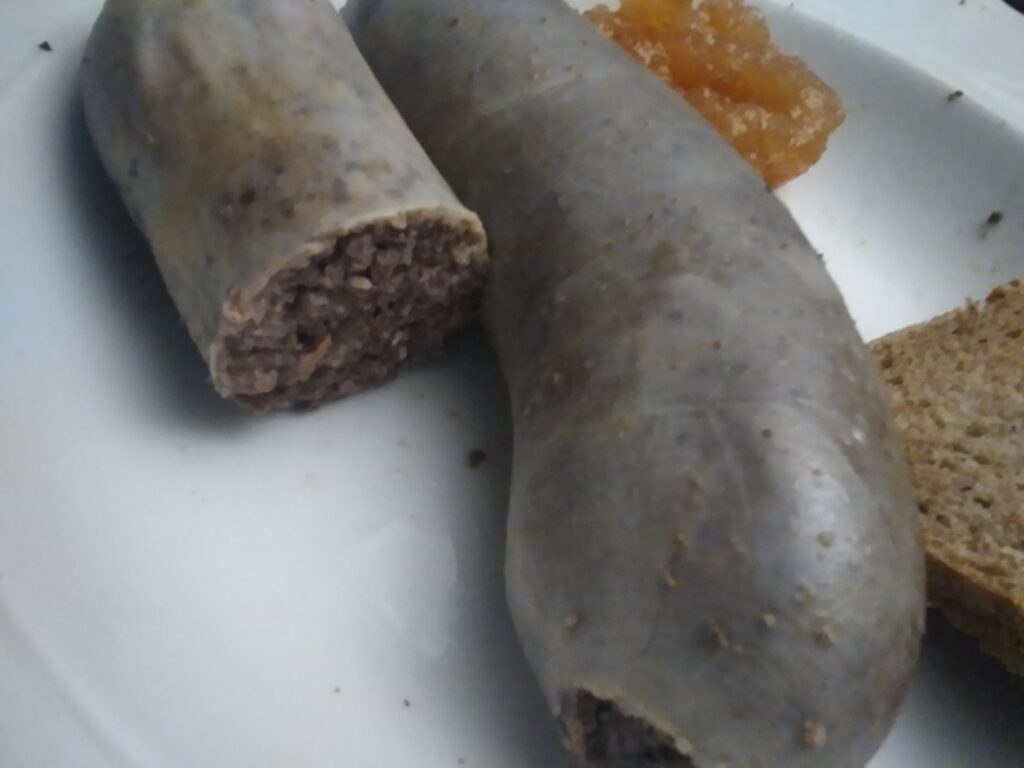A first test based on two similar recipes, both from the mid-sixteenth century. The first is from our already familiar Sabina Welser:

If you want to make good liver sausage
Firstly, take a quarter of a sow’s liver, and a quarter of the lung of a sow. Chop these small, then cut bacon into small cubes and add salt and caraway. The liver and lung need to be boiled before you chop them. Then pour some of their broth into the chopped meat, as much as you think good. Then you must take the gut from the butcher and stuff it into that. That way you have good sausage.
The second is recipe #169 from the Kuenstlich und Nuetzlich Kochbuch by Balthasar Staindl, a successful recipe collection that first appeared in 1544.
Of sausages of veal and beef, also of lung and liver
Take the liver of a beef, and also the lung. Chop each separately very small, then chop both together and put them into a wooden vat. Salt it, add a dusting of pepper and a little good fat that is not cut too small, otherwise it cooks away entirely.Then pour in sweet cream and stir it all together. Take wide guts of an ox and fill it into them loosely, tie them with string at either end and sauté (uberbrenn) it. Such sausages are very good on kraut and rüben, they are very mild. You may also make a sausage of a veal liver with or without cream.
This is basically the same sausage except for the seasoning and the use of cream rather than broth in the second. I had not tried it before and since I already had a lung, I also got a pound of veal liver and went ahead. We ground the parboiled lung and liver, about 500g each, and added about 300g of fat bacon cut into cubes. Since everything was already cooked, I decided to add salt and pepper to taste and poured in about half a cup of cream. Then we stuffed the filling into beef gut casings and simmered them for about 20 minutes. The result was underwhelming.

The taste was all right. Liver dominated a bit too much and caraway might actually have helped here. It harmonised well with the dewericz sauce. But the consistency was very unpleasant. The filling separated into chewy nodules packed around the rubbery bacon cubes. It was too dry and impossible to eat comfortably except with a spoon. The recipe has potential, but next time I must a) grind the meat more finely, b) add more liquid and c) use more bacon cut into much smaller pieces. It might be best to grind it.
The liver sausage went very well with the dewericz apple sauce from Meister Hans:

Meister Hans Recipe #82 Ain Condiment haist dewericz
A sauce that is called dewericz
Item take a sour apple after St Martin’s Day (11 November), peel them and cut them apart. Then lay them in a honey beverage (hönig tranck). Let it boil so that it turns brown. You may keep this for a year. This sauce is called dewericz. You may also fill krapfen (small pastries) with it.
As recipes go, this is fairly straightforward. The main question is what hönig tranck is – mead, honeyed wine, or honey water? In this recipe, I opted for diluted honey without any fermentation, with just enough water to make it cook the apples without caramelising. After about 45 minutes of gentle simmering (and two instances of boiling over – watch out for that!), the resulting sauce was thick, sweet, and powerfully aromatic. To make it last a year would probably have taken another 30 minutes or so of cooking, but we were happy with it as it was.
